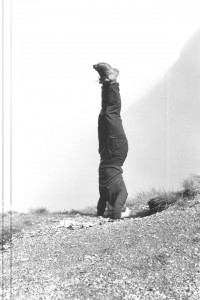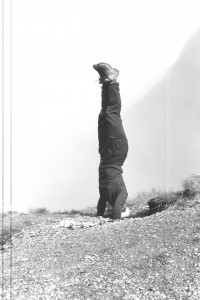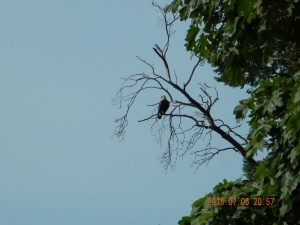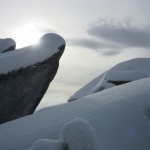
You don’t have to Stand Upside Down to Adopt a Different Perspective
My son is moving to California, so he is (finally) cleaning some of his stuff out of our attic. He found this photo from 2006 when my family hiked the Inca Trail to Machu Picchu. (has it been 10 years? Really?!) We had just crested the highest point, at over 13,000 feet. I remember how challenging it was to hike at elevation: my lungs were the weakest in the group and I lagged a good 20-30 minutes behind the sherpas, my sons, and my partner. I would set a goal to hike one length between switchback turns without stopping. Sometimes I’d only make it half way. I’d lean to rest on my hiking pole, gasping for breath and hoping my lungs wouldn’t implode. Did I feel the need to do a headstand to save face and show that I had mastered another kind of strength? Maybe. Probably. I know I’m glad my son got it on film.
I remember how powerful I felt in that pose. The Andes are a young mountain range, geologically speaking. They pierce the sky with bravado and invite challenge. That day they filled me with a sense of invincibility beyond just saving face. Even if I couldn’t keep up with the men, I could find strength in ways that were available to me. At home I had a strong headstand practice, but I was used to a smooth oak floor, with a blanket to cushion my head, and breathing oxygen-saturated air at sea level. It made me nervous to think about being upside down on a rocky cliff, but I wasn’t thinking as much as responding to the earth. I felt like I wanted to dive head first into the head of the mountain. Crown to crown with the massive body of the earth, I reached up strongly through my feet and felt my own body eager to expand. All the things I knew to do in the yoga studio showed up so I could open to a larger experience of myself.
Physical travel often informs my inner journeys, and my experience atop the Andes is a great example. As my hormones change and my body ages, (a journey that can rival the most extreme adventure travel in terms of challenge) I have called upon the power of not just the Andes, but mountains in general to help me navigate this unfamiliar territory. If you practice yoga, you know that Mountain Pose is actually an upside down headstand: it is a standing pose that calls us to find our power in a simple upright stance. It invites us to recognize our relationship to gravity by imagining our feet like roots into the ground. Not unlike the way headstand helped me claim upside down connection with the earth at 13,000 feet, mountain pose reminds me how to find balance even when I hobble stiffly to the bathroom in the middle of the night. I am continually reminded that the simple things my body knows how to do on the yoga mat are always available to help me navigate my life in more conscious ways.
In South America, I gained an appreciation for the deeper wisdom of my own nature, but I was also reminded of the deeper wisdom available to me when I acknowledge other aspects of nature as well. The Incas compare the landscape to animals: they recognize how rivers move like snakes, often disappearing underground. For them, the concepts of water as a metaphor for the emotional unconscious and reptiles as representatives of our more primitive selves are more than psychological theories; they are phenomena in nature that are available to connect with and to learn from. They look to the puma, a strong, elegant mammal to inspire humans how to tread on the surface of the earth and they observe the condor to gain insight into the realms of the spirit. Looking to the animals as teachers and allies, although not completely foreign to me, was not something I thought deeply about. I did downward dog and cat cow: domestic animals were in my awareness, but to reach out to the wild ones for guidance was foreign to me. If I looked to the animals for insight, would I encounter my own wild nature? What would that be like and how does one go about doing it?
Before the trip, I remember dreaming about an eagle and a condor. The eagle was emaciated and his feathers were dried and frayed. I was disturbed by the uncharacteristic condition of an otherwise regal bird. The condor was strong and stood in stark contrast to the frail eagle. He seemed intolerant of the eagle’s weakness. Both birds were in front of me on a beach by the ocean. Was this a reflection of something in my own life? The dream was haunting and the images settled into my bones where they seemed to wait until I could understand them more clearly.
It was an experience I had after returning from the trip that shed light on the meaning of my dream. I found a desiccated eagle feather. On a walk along the Puget Sound beach by my home, I saw it half buried in the sand amid some dried seaweed. It was big: 16 or 18 inches. I don’t think it was very old, as it was still dark brown and it had a strong, supple feel to it, but it was raggedy and bare in places. Picking it up seemed to unlock the memory of the dream from my bones. I wondered about the bird that lost this feather and the sad image of the eagle from my dream came to mind. It scared me. I quickly dropped the feather and moved on. But the incident was not easily forgotten. What turn of synchronicity placed the feather in my path and prompted me to notice it? The dread of my own mortality surrounded me like a fog. I felt vulnerable and helpless, as if I was the raggedy raptor. It occurred to me that the Incas would look to these animal images to glean wisdom. The strength of the condor had been equally present in my dream so I vowed to pay attention to ways in which I become worn down or struggle like the eagle and to look for ways to claim the strength of the condor, like I did on the Inca trail: finding my own way of power.
Travel is great for changing perspective, as is yoga, especially the upside-down poses, but we don’t have to go that far to find the change we seek. Our dreams are rich in imagery that can change our perspectives, but so is our immediate environment. Robert Moss, author of Conscious Dreaming encourages dreamers to expand perspective by learning to converse with wiser selves and with allies in both waking and sleeping consciousness. The Incas suggest ways to engage with the spirits of the land, as do many cultures that honor connection with the natural world. By paying attention to our every day sensory experiences, we can learn to interpret the subtle ways in which nature reveals secrets that heal us and keep us vital.
We are lucky to live in the Northwest where eagles and shorelines, trees and abundant wildlife regularly interrupt our awareness, but our interest in the constructs of our culture: cars and computers, phones and work schedules and manufactured deadlines can obstruct our vision. When I start to feel stuck or uninspired, I look for ways to turn my perspective upside down. Even taking out the trash can be trigger to notice squirrels and birds and plants. I can’t tell you how many times the stellar jay reflects my own behavior with her loud complaining. The dry brown leaves littering my deck in June remind me that water is precious and motivate me to consider my own conservation projects. But making friends with our natural allies is not another thing to put on the to-do list: we get better at it if we can enjoy it. I encourage you to look for ways to take a vacation from the mundane at least once a day.
Consider joining Carrie Lafferty, PT and I at Mosswood Retreat Center in January for a seasonal reset. Read about Being and Doing, a retreat where we will enjoy nature and remind ourselves how to tap into the rich wisdom that is ours if we pay attention.







